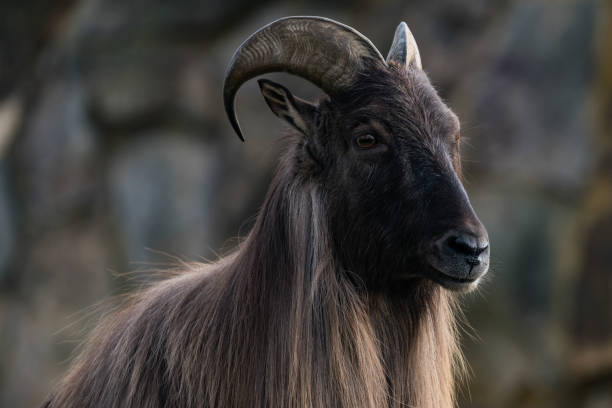Himalayan Tahr (Hemitragus jemlahicus)
Table of Contents
Scientific Classification
| Kingdom | Animalia |
| Phylum | Chordata |
| Class | Mammalia |
| Order | Artiodactyla |
| Family | Bovidae |
| Genus | Hemitragus |
| Species | Hemitragus jemlahicus |
| Scientific Name | Hemitragus jemlahicus |
1. Description
The Himalayan tahr is a resilient, goat-like herbivore that calls the stunning alpine landscapes of its home its own. With a broad, barrel-shaped body and sturdy, short legs, this animal is perfectly adapted to its chilly, steep environment. Its thick coat can vary from a warm reddish-brown to a deep, dark brown, providing excellent insulation. The mature males are particularly eye-catching, sporting long, shaggy manes that cascade from their shoulders. Their impressive horns curve back in a graceful crescent and can reach lengths of up to 45 cm (18 inches). Females, while also horned, have smaller and thinner ones, and they lack the dramatic mane.
In terms of size, males typically weigh between 70 to 120 kilograms (154 to 265 pounds), while females are lighter, averaging around 36 to 60 kilograms (79 to 132 pounds). Both genders possess a calm yet intelligent demeanor, characterized by their large, observant eyes and strong hooves that enable them to navigate rocky terrains with ease.
While this stocky ungulate may not flaunt any flashy features, there’s an undeniable sense of dignity about the tahr. Every part of its physique tells a timeless tale of survival in the rugged Himalayas.
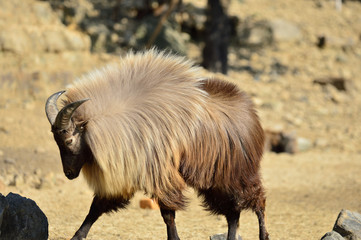
2. Distribution
The Himalayan tahr calls the majestic Himalayan mountain range its home, primarily found in northern India, Nepal, and southern Tibet. You can spot these mountain-dwelling creatures in the high-altitude regions of Uttarakhand, Sikkim, and Bhutan.
Interestingly, the tahr has also made a name for itself far from its original habitat. In the early 1900s, it was introduced to New Zealand’s Southern Alps for game hunting, and since then, it has thrived there, forming robust populations. You can also find smaller groups in places like South Africa, Argentina, and the United States.
While the tahr is well-known in the Himalayas, it truly shines in the rugged cliffs and shadowy valleys of this region, symbolizing the strength and resilience of alpine life.
3. Habitat
The Himalayan tahr is a remarkable creature that thrives on steep, rocky slopes and in the beautiful alpine meadows. You can usually find them at altitudes ranging from 2,500 to 5,000 meters (8,200 to 16,400 feet) above sea level. These heights are definitely not for the faint of heart, as they come with snow, fierce winds, and thin air. But the tahr? They’re perfectly suited for this rugged environment.
They have a preference for south-facing slopes, where the snow melts earlier in the spring. This gives them a head start on reaching fresh vegetation. As the seasons change, tahrs adjust their altitude accordingly, heading down to lower elevations during the harsh winters and climbing back up as the snow begins to melt.
Their habitats also include lush forested valleys, vibrant rhododendron thickets, and subalpine scrublands. While these animals are incredibly resilient, they can be quite elusive. They tend to stay high up in the mountains and only venture down to the lowlands when they’re under significant pressure.

4. Diet
Himalayan tahrs are naturally herbivorous and have a pretty interesting approach to their diet. They’re selective but also opportunistic eaters, which means what they munch on can change with the seasons and what’s available. Their main menu includes:
– Grasses
– Shrubs
– Leaves from small trees
– Herbs
– Mosses and lichens, especially during the winter months
When the growing season rolls around, they feast on nutrient-packed alpine plants like sedges and forbs. But come winter, when the ground is blanketed in snow, they switch to heartier fare like coarse grasses and bark.
Thanks to their multi-chambered stomach, similar to other ruminants, they can efficiently digest fibrous plants and extract all the nutrients they need.
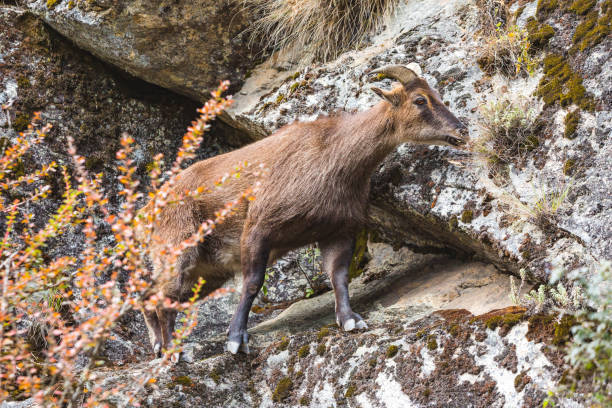
5. Behavior
Tahrs are primarily crepuscular creatures, meaning they’re most active during the early morning and late afternoon. During these times, you can find them foraging, climbing, and skillfully navigating their rugged mountainous habitat.
Socially, tahrs prefer to hang out in small herds, which typically include females and their young ones. Males, on the other hand, tend to roam solo or form bachelor groups, especially when it’s not breeding season. But when the rut comes around, the males really step up their game, competing fiercely for the attention of females. They showcase their strength and dominance through impressive displays and, at times, engage in fights.
These animals are quite skittish and always on high alert, cleverly using the elevation and terrain to their advantage. A sudden loud noise or a quick movement can send them leaping up cliffs in a flash. They have a knack for disappearing into rocky areas where few predators or humans can follow.
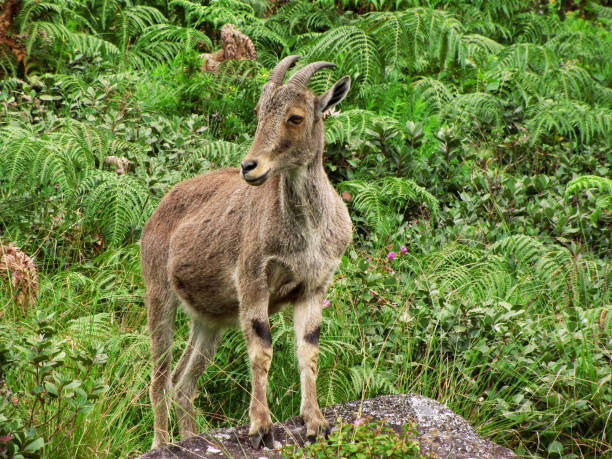
6. Lifespan
In the wild, Himalayan tahrs usually live 10 to 14 years. Some can even reach 16 years if conditions are good. In captivity, threats are low, and medical care is available. So, they can live a few more years.
Environmental pressures greatly affect their lifespan. Key factors include predation, food availability, and harsh weather.
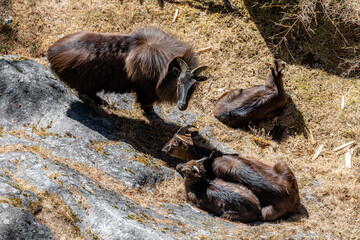
7. Reproduction and Lifecycle
The Himalayan tahr has a fascinating seasonal reproductive cycle. They mate during the winter months, and by spring, the females give birth to their young. This timing is perfect since fresh plants are abundant, providing plenty of food.
Key Lifecycle Stages:
Gestation Period: Lasts about 180 to 220 days, which is roughly 6 to 7 months.
Birth: Typically, a single kid is born, although twins can happen, albeit rarely.
Weaning: Takes place around 3 to 6 months after birth.
Parental Care: Mothers are incredibly attentive, keeping their young close and choosing safe spots for nursing and resting.
One remarkable aspect is that the young tahr is up and moving within minutes of being born, a crucial adaptation for surviving on steep cliff faces.
8. Predators
In the wild, the Himalayan tahr must constantly be on guard against several predators. Key among them are:
- Snow leopards – their most formidable natural enemy.
- Wolves and Himalayan black bears – opportunistic hunters.
- Golden eagles – known to snatch young or weak individuals.
Tahrs rely more on escape than confrontation. Their sharp vision and ability to scale cliffs quickly serve as their best defense. One misstep, however, can be fatal on the jagged slopes.
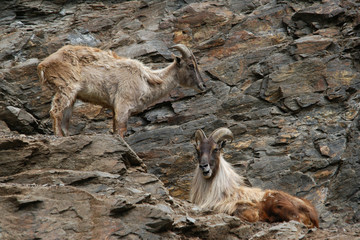
9. Adaptations
The tahr has evolved in fascinating ways to thrive in its high-altitude home. Here are some of its standout adaptations:
– Specialized hooves with soft, rubbery centers that give them a solid grip on rocky terrain.
– A thick, double-layered coat that keeps them warm in the chilly air.
– A compact body shape designed to reduce heat loss.
– Incredible balance and agility, allowing them to scale steep cliffs with ease.
– Sharp senses of smell, hearing, and vision, which are crucial for spotting predators early on.
These remarkable adaptations have developed over thousands of years, perfectly suited to the challenges of their rugged environment.
10. Mating Season
The Himalayan tahr mates in late autumn to early winter. This rut usually happens from October to January. During this time, males become visibly more active and competitive.
They descend from solitary ranges to join female herds and begin establishing dominance. Larger males with bigger horns and shaggier manes often assert superiority through:
- Displays of strength
- Posturing
- Chases and occasional head-butting
Strong males mate with several females. This helps their genes pass to the next generation.
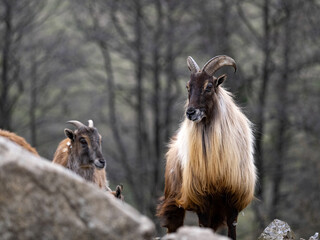
11. Breeding
Once mating occurs, females begin their slow gestation over the harsh Himalayan winter. When spring comes, usually from April to June, she looks for a safe, hidden spot to give birth.
The single kid is precocial — able to walk and even climb shortly after birth. The mother takes care of her young for months. She nurses and protects them. Then, she slowly introduces them to the main herd.
Male offspring usually leave their mother’s group after a year. In contrast, females often stay longer or even for life. This helps keep the herd stable.
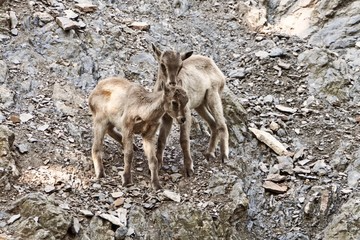
12. Interesting Facts
- Relatives of wild goats: The Himalayan tahr is related to wild goats but belongs to a different genus.
- New Zealand icon: Tahrs are common in New Zealand. They are a popular game species but also seen as a threat to native plants.
- Voice of the wild: They make deep, low sounds. These are often used by mothers and their young.
- Strong swimmers: Though rare, they can swim across rivers if needed.
13. Conservation Status
The IUCN Red List currently lists the Himalayan tahr as “Near Threatened.” While their populations are stable in many areas, they still face several ongoing threats:
Key Threats:
– Habitat loss from deforestation and human encroachment.
– Hunting for meat, trophies, and traditional medicine.
– Competition with livestock, which limits their food sources.
– Climate change, which is altering the alpine ecosystems they rely on.
In Nepal and India, various conservation initiatives and national parks are working to protect local wildlife. However, finding the right balance between human development and ecological preservation continues to be a tricky challenge.

Conclusion
The Himalayan tahr may not grab headlines like a tiger or an elephant, but it plays a vital role in our ecosystem. These serene mountaineers are a testament to nature’s ingenuity. They navigate steep terrains that most animals wouldn’t dare to tread. Found on the rugged cliffs of the Himalayas and in New Zealand’s Southern Alps, the tahr showcases incredible balance and a remarkable ability to adapt to its surroundings.
To ensure the survival of this extraordinary creature, we need to implement protective policies and show appreciation for what it represents: resilience in the face of adversity.


